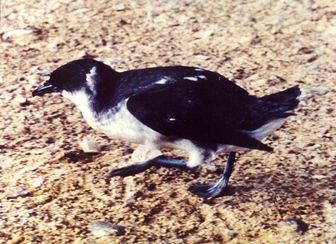Peruvian Diving Petrel
The Peruvian diving petrel has become locally extinct on many of its former colonies and nests nowadays only on a few offshore islands. A total population of 12 216 breeding pairs was estimated for San Gallán and La Vieja Islands in Peru, with some small additional breeding colonies reported for Corcovado Island in Peru, as well as Pan de Azucar Island, Choros islands, Grande and Pajaros islands in Chile. They breed year round, laying a single egg in a burrow dug into guano.

Permission: GNU Free Documentation License
The Peruvian Diving Petrel is classified as Endangered (EN), considered to be facing a very high risk of extinction in the wild.
The Peruvian diving petrel has become locally extinct on many of its former colonies and nests nowadays only on a few offshore islands. A total population of 12 216 breeding pairs was estimated for San Gallán and La Vieja Islands in Peru, with some small additional breeding colonies reported for Corcovado Island in Peru, as well as Pan de Azucar Island, Choros islands, Grande and Pajaros islands in Chile. They breed year round, laying a single egg in a burrow dug into guano. More
The Peruvian diving petrel (local name in Peru: Potoyunco) belongs to the family Pelecanoides (Diving Petrels) represented worldwide by only four species. Historically the species was ranking from the islands of Lobos de Tierra (6° south) in Peru to Corral, Chile (37° south). More
Aspects of the topic Peruvian diving petrel are discussed in the following places at Britannica. Assorted References * type of diving petrel (in diving petrel (bird)) ...The smallest and most widespread is the common diving petrel (Pelecanoides urinatrix), about 16 cm (6.5 inches) long; the largest is the Peruvian diving petrel (P. More
The Peruvian Diving Petrel Pelecanoides garnotii is a small seabird that feeds in offshore waters in the Humboldt Current off Peru and Chile. Like the rest of the diving petrels it is a nondescript bird, with a dark back and pale belly, and blue feet, and can be separated from the rest of its family only by differences in its beak and nostrils. More
Historically the Peruvian diving petrel was ranging from the islands of Lobos de Tierra (6° south) in Peru to Corral, Chile (37° south) (1) . It is estimated that the Peruvian diving petrels original population some 80 years back was counted in several millions, with the main colonies at the islands of Chincha, San Gallan, La Vieja, Ballestas, Mazorca, Lobos de Tierra, Macabí, Guañape, Pescadores, Lobos de Afuera, Ancón, Callao and Arica in Peru, as well as Iquique, Taltal and Valparaíso in Chile. More
Conservation Actions for Peruvian Diving Petrel in the Pisco Area, Peru Location: Pisco, Peru Species: Peruvian Diving Petrel (Pelecanoides garnotti) Abstract: The Peruvian diving petrel (Pelecanoides garnotii) is a threatened marine bird endemic of the Humboldt Current and classified as "Critically Endangered" at both national and international levels. Main causes for its population decline are human-related, together with the little the public knows about this species. More
The Peruvian Diving Petrel nests on a few offshore islands, foremerly in dense colonies, although now more frequently in small groups. They breed year round, laying a single egg in a burrow dug into guano. Peruvian Diving Petrels are considered highly endangered. More
Family : Pelecanoididae
Genus : Pelecanoides
Species : garnotii
Authority : (Lesson, 1828)
